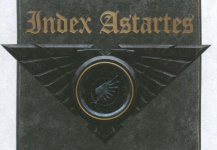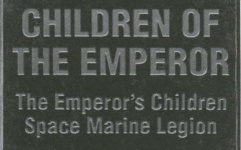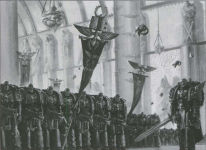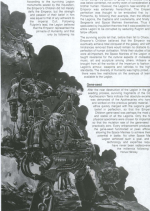

For countless centuries, stretching back to the ancient times of the Horus Heresy, the corrupted Space Marines of the Emperor's Children Legion have been the bane of the Imperial Inquisition, spreading their foul and decadent ways across the galaxy like a plague of immorality. Loyal Inquisitors train for decades to steel themselves against the temptations of Slaanesh in order to combat this seductive, deadly threat to Imperial order. Yet, long ago, these agents of Chaos were counted among the servants of Mankind; indeed, they once were the most devoted warriors of the Emperor.
Origins
ong ago, during the Age of Strife, warp travel became impossible and all the worlds which humanity had claimed were cut off from one another, forced to fend for themselves without the support of their neighbours in other star systems The Libram ex Dominar, one of the few surviving texts from this time, tells that Chemos was one such world, a mining colony dependent on interstellar trade for food. The planet's rulers made every effort to extract enough raw food from the harsh environment to feed their people, but Chemos was a world dying a slow death. This all changed when one day the guards on the walls of Callax, the largest remaining factoryfortress, saw a meteor descend from the clouds, trailing fire across the sky before impacting barely a mile from the fortress walls. Though little manpower could be spared, the ruling Executive of Callax sent a handful of scouts to investigate the impact site, hoping for some evidence of human survivors on other worlds. What they found became legend.
In the centre of the crater, surrounded by the white-hot remains of a stasis capsule, was a child, barely more than a baby. Orphans were normally put to death on Chemos — the Executive spared no resources to look after those who were unable to return their investment by working in the factories — but the captain of the Callax scouts looked into the eyes of the child and saw something more than human. In defiance of tradition, the captain of the scouts appealed to the Executive. Because of his value to Callax, the captain was allowed to adopt the infant as his own. He named his adopted son after an old legend long-since discarded by the people of Chemos, the mythical god of creation Fulgrim. The child named after this legend soon created a legend of his own, one that would become known to all the people of his world.
Fulgrim grew unnaturally fast, becoming a strong, capable man. At half the age of his fellow workers he was able to fulfil his obligations to the Executive, working for days without rest. Not only was he physically proficient, he quickly grew to understand the technology of the machines he worked with, and began to contemplate their improvement. By the fifteenth anniversary of his fall from the sky, Fulgrim had risen from the tanks of the workers, first becoming an engineer then one of the Executive itself. Learning of the slow deterioration in Callax and the other settlements of Chemos, Fulgrim set himself the task of saving his world.
One by one he convinced his fellow members of the Executive to fight against the entropy that was destroying Chemos. Under Fulgrim’s leadership, teams of engineers travelled far from the factory-fortresses, reclaiming long-dead outposts in the planet's most inaccessible regions. The ancient mines were reopened and expanded, bringing more and more minerals into Callax and allowing the construction of more sophisticated machines. Recycling efficiency grew until, at last, Callax was producing more than it consumed. Seeing his people prosper, Fulgrim took pride in fostering the re-emergence of art and culture, reclaiming the spirit of humanity that had been sacrificed so long ago in the struggle for survival. As Callax grew, the other settlements began to ally themselves with Fulgrim. Fifty years after Fulgrim fell from the sky he rose to sole rulership of Chemos.
it was not long after this that the planet's isolation came to an end. From the grey sky came a flight of dropships, armoured and battle-scarred, each bearing the same symbol, a two-headed eagle. On hearing of this, some fragment of memory stirred in Fulgrim. Chemos had no formal army, but the dropships’ landing zone had been surrounded by the Caretakers, the police-soldiers responsible for maintaining order in the factory-fortresses. Fulgrim sent word to the Caretakers to stand down and allow the visitors from above into Callax.
In his spartan quarters, Fulgrim was faced by armoured warriors from the stars. Their faces bore the scars of many battles, and from their shoulders hung scrolls listing their achievements. Their armour and weapons were finelyworked, and their banners and pennants were works of art. Fulgrim recognised that these men were not merely advanced, but civilised — his lost brothers from the stars had preserved the arts he had longed to return to Chemos. From the midst of these warriors stepped their leader, the Emperor of Humanity. Fulgrim surveyed him and, without a word, knelt and offered his sword. On that day Fulgrim swore to serve the Imperium with all his heart.
From the Emperor himself, Fulgrim learned of Terra, of the Great Crusade to reclaim the galaxy, and of his own origins.






